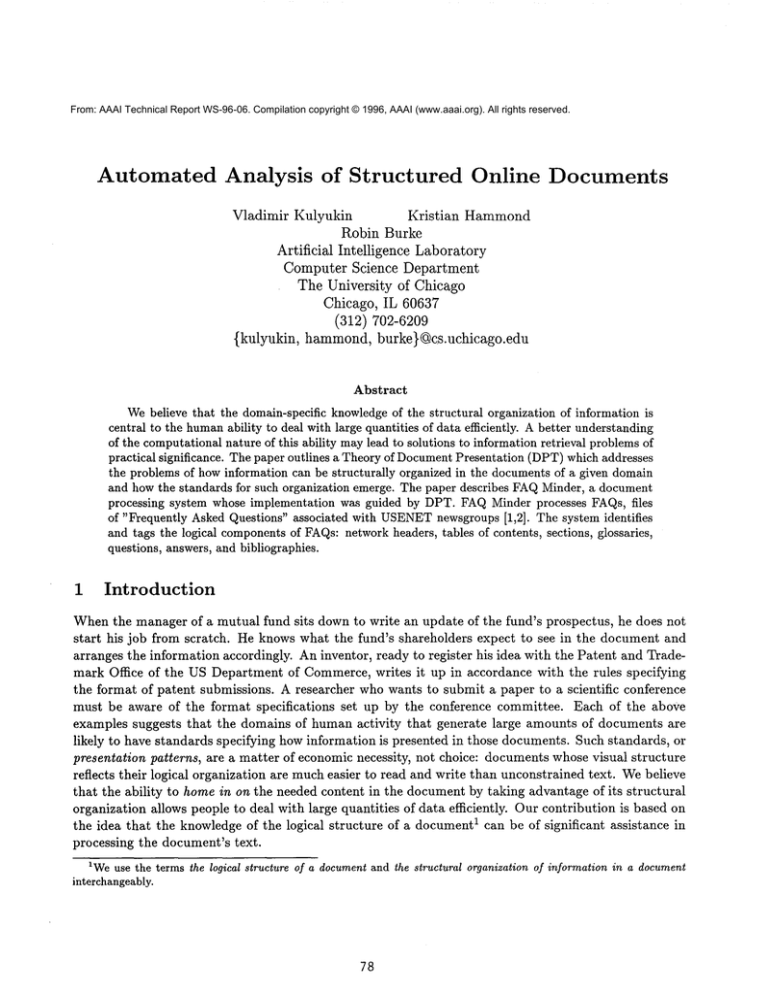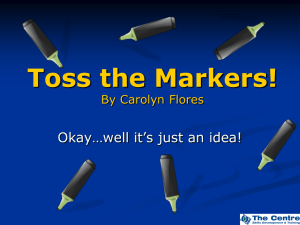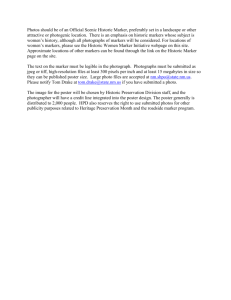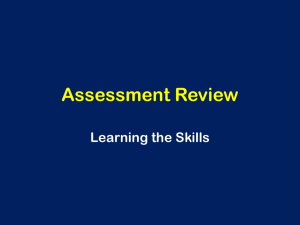
From: AAAI Technical Report WS-96-06. Compilation copyright © 1996, AAAI (www.aaai.org). All rights reserved.
Automated
Analysis
of Structured
Online Documents
Vladimir
Kulyukin
Kristian
Hammond
Robin Burke
Artificial Intelligence Laboratory
Computer Science Department
The University of Chicago
Chicago, IL 60637
(312)702-209
{kulyukin,
hammond, burke}@cs.uchicago.edu
Abstract
We believe that the domain-specific knowledge of the structural
organization of information is
central to the human ability to deal with large quantities of data efficiently.
A better understanding
of the computational nature of this ability may lead to solutions to information retrieval problems of
practical significance.
The paper outlines a Theory of Document Presentation
(DPT) which addresses
the problems of how information can be structurally
organized in the documents of a given domain
and how the standards for such organization
emerge. The paper describes
FAQMinder, a document
processing
system whose implementation
was guided by DPT. FAQ Minder processes
FAQs, files
of "Frequently Asked Questions" associated
with USENETnewsgroups [1,2]. The system identifies
and tags the logical components of FAQs: network headers, tables of contents, sections, glossaries,
questions, answers, and bibliographies.
1
Introduction
Whenthe manager of a mutual fund sits down to write an update of the fund’s prospectus, he does not
start his job from scratch. He knowswhat the fund’s shareholders expect to see in the document and
arranges the information accordingly. An inventor, ready to register his idea with the Patent and Trademark Office of the US Department of Commerce,writes it up in accordance with the rules specifying
the format of patent submissions. A researcher whowants to submit a paper to a scientific conference
must be aware of the format specifications set up by the conference committee. Each of the aboVe
examples suggests that the domains of humanactivity that generate large amounts of documents are
likely to have standards specifying howinformation is presented in those documents. Such standards, or
presentation patterns, are a matter of economicnecessity, not choice: documentswhose visual structure
reflects their logical organization are mucheasier to read and write than unconstrained text. Webelieve
that the ability to homein on the needed content in the documentby taking advantage of its structural
organization allows people to deal with large quantities of data efficiently. Our contribution is based on
the idea that the knowledgeof the logical structure of a document1 can be of significant assistance in
processing the document’s text.
1Weuse the terms the logical structure
interchangeably.
of a document and the structural
organization of information in a document
2
DPT: What is
the
Problem?
DPTemerged from the ongoing research on FAQFinder [1], an automated question-answering system
whose main source of knowledge is the files of "Frequently Asked Questions" (FAQs) [2]. FAQFinder
answers natural language queries by matching them with the questions in its FAQsand returning the
answer to the best match. Given a query, it selects a small number of probabilistically most relevant
FAQs. Each FAQin the FAQlibrary is a vector in a multidimensional space of terms selected by
the SMART
system [7]. Each question in a FAQindexes the corresponding answer in a semantic net
derived from Princeton’s WORDNET.
FAQFinder matches the query against each question in the
selected FAQsby passing markers in the net. It returns the answer to the question that scored the
largest numberof node intersections with the query.
Whenwe started working on the question matching module of FAQFinder, we were confronted
with the problem of how to reliably identify questions, answers, tables of contents, glossaries and
bibliographies in arbitrary FAQs.The problem is important because in order to answer questions about
the contents of a FAQit is useful to know its logical structure. For example, the frequent question
What is FAQX all about? can be answered by displaying X’s table of contents. A good answer to the
question What books can I read about X? is the bibliography of a FAQabout X. The semantic matching
of questions and the retrieval of answers are impossible unless it is knownwhich text regions of a FAQ
are questions and which are answers. The problem is not trivial because neither parsing nor statistical
word-basedtechniques are suitable for the job: state-of-the-art parsers are too limited in their scope of
application; statistical methods mostly ignore the structural organization of text. DPTwas developed
as an attempt to find a comprehensive solution to the problem of howto identify the logical structure
of a document.
3
DPT: Premises
and Objectives
DPTis based on the following premises:
Economic Necessity Premise: The higher the demand for a class of documents, the higher the
chances that the presentation of information in those documentswill adhere to a small set of rigid
standards. Prospectuses of mutual funds, 10-Q forms, FAQsare but a few examples of document
classes that emerged because of economic necessity and were standardized by consumer demand.
Text-As-a-Syntactic-Object
Premise: As a source of information, text can be viewed as a
syntactic object whosestructural organization obeys certain constraints. It is often possible to find
the needed content in a documentby using the structural organization of its text.
Presentation Consistency Premise: Document writers are consistent in their presentation
patterns. They do not change the chosen pattern within a single document; many of them stick
with the same pattern from document to document.
Presentation Similarity Premise: The logical components of a document that have the same
semantic functionality are likely to be markedin the same or similar fashion within a presentation
pattern. Documentwriters tend to mark headers, tables, sections, bibliographies, etc., in the same
or similar ways in documenttexts.
79
4
Orthographic
Markers and Their Sequences
The basic unit of the DPTformalism is the orthographic marker. Documentwriters use orthographic
markers to specify the logical structures of documents; documentreaders use such markers to recognize
those structures and home in on the needed content. Figure 1 gives a table with examples of some of
the markers 2 found in many FAQs. Markers arrange themselves in marker sequences; sequences signal
presentation patterns.
No
Marker Types
alpha
alpha
alpha
alpha
alphanumeric
alphanumeric
alphanumeric
alphanumeric
symbolic
symbolic
Markers
"Q:"
.
"A:"
.
.
.
.
.
.
0
"Subject:"
"Section:"
,,[1-0]"
"1)"
"lO.2a"
"VIII."
,,**************,,
.
10.
Figure 1: Markers and Marker Types
5
Constraints
on Logical Structure
To accurately describe the logical structure of a document, it is necessary to reason about the marker
sequences found in it: how they begin, get interrupted, restart, and end. The problem here is sequence
tracking: how does the document reader, a person or a program, follow a marker sequence through the
document. Wehave developed a set of constraints that specify how marker sequences behave in FAQs.
FAQMinder has four types of constraints. Each constraint is defined with respect to one of the three
types of marker sequences. For lack of space, we give one example per constraint type:
Recursion Constraints: Alphanumeric sequences do not recurse.
< seql > [1]
< seql > [2]
< seql > [3]
........
< seq2 > [1]
....
....
....
text
....
text
text
text
.....
text
E.g.,
.....
.....
.....
.....
The recursion constraint forces the second "[1]" marker to start a new alphanumeric
sequence < seq2 > and does not allow the first sequence < seql > to continue.
2We use the terms markers and marker sequences
to refer
8O
to orthographic
markers and orthographic
marker sequences.
Crossing Constraints: A symbolic sequence does not cross another symbolic sequence if the latter
has started before the former. E.g.,
< seql > *********************
< seq2 > - . .... text ......
< seq2 > - . .... text ......
< seql > **********************
< seq3 > - . .... text ......
< seq3 > - . .... text ......
< seql > **********************
Here the crossing constraint forces the third "-" marker from above to start a new sequence seq3.
If it belonged to seq2, seq2 would have to cross seql, which the crossing constraint does not allow.
Stable Marker Structure
their markers. E.g,
Constraints:
Orthographic sequence do not change the structure
< seql > (1) ..... text
< seq2 > (1.1) .....
< seq2 > (1.2) .....
< seql > (2) ..... text
< seq3 > (2.1) .....
of
.....
text .....
text .....
.....
text .....
In this configuration, the marker "(1.1)" signals a change of marker structure from (lp integer
rp) to (lp integer dot integer rp). The violation of this constraint often signals the start of
subsequence. In this case, seql has two subsequences - seq2 and seq3.
Proximity Constraints: When the extenders of two different sequences with the same marker
structure can extend on the same marker, only the sequence whose head marker is closer to the predicted
markeris allowed to extend on it. E.g.,
< seql > A: ..... text
< seql > B: ..... text
........ text .....
< seq2 > A: ..... text
< seq2 > B: ..... text
< seq2 > C: ..... text
.....
.....
.....
.....
.....
The marker "C:" becomes an element of seq2 because its head marker "B:" is closer to "C:" than the
same head marker of seql.
6
LOGICAL
MAP AND LAYOUT
Documentwriters frequently use markers in conjunction with layout. One way to compute the layout of
a document is to digitize its text line by line according to a simple coding scheme. The coding scheme
81
implemented in FAQMinder treats each line of a document as a string. Each substring of the string
is mappedinto the integer denoting its length. The special layout characters like newline, tab, and
space are mappedinto the integers 1000, 2000, and 3000, respectively. This scheme works because all
FAQsin our library have lines that are at most 100 characters long. The database of assertions about
sequences detected in the text of a documentis referred to as its logical map. The presentation pattern
of a document is determined by its logical map and its layout. As an example, consider the following
chunk of text with the layout characters madevisible:
<line
<line
<line
<line
<line
<line
<line
0
1
2
3
4
5
6
>
>
>
>
>
>
>
Tab Tab Space [1] first line.
Newline
Tab Tab Tab Space [1-0] second line.
Newline
Tab Tab Tab Space [1-1] third llne.
Newline
Tab Tab Space [2] fourth line.
The layout of the above text computed according to our scheme is:
(2000200030003 5 5)
(1000)
(20002000200030005 6 5)
(1000)
(2000 2000 2000 3000 5 5 5)
(lOOO)
(2000 2000 3000 3 6 5).
The logical map of the text follows. The symbols lsb, rsb and hph stand for left square bracket,
right square bracket and hyphen respectively:
(alphanumeric-sequence
(occurs-on-line
seql (lsb
(occurs-on-line
seq2 (lsb
(occurs-on-line
seq2 (lsb
(occurs-on-llne seql (lsb
7
seql)
1 rsb)
1 hphn 0 rsb)
1 hphn 1 rsb)
2 rsb)
FAQ Minder: An Automated Document Processor
DPThas guided our implementation of FAQMinder, a document processor which identifies the logical
structures of FAQs,i.e. identifies and tags network headers, tables of contents, questions, answers,
sections, glossaries and bibliographies. FAQMinder works in two modes: supervised and unsupervised.
In the unsupervised mode, the system takes as input the text of a FAQand attempts to recognize its
logical structure on its own. The current implementation deals only with tables of contents, questions
and answers. In the supervised mode, FAQMinder identifies the logical structure of the document by
interacting with the user through a set of simple interfaces. Figure 2 shows the modules of FAQMinder.
82
DOCUMENT
SEQUENCE]
LIBRARY
]
TEXT
-I
LAYOUT
I r.j
I .OCU ENT I
SE~O~ENCE
]---t-----4~
ACTIVE
MARKER
INFERENCE
T
LOGICAL
MAP
SEQUENCES
Figure 2: FAQMinder’s Modules
The Sequence Manager reads the text of a document, builds its layout and activates and deactivates
marker sequences. The Inference Engine manages the logical map and the constraint satisfaction. The
Tagger inserts tags into the text of the document given the document’s layout and logical map.
FAQMinder reads documents line by line. After a line is read, the Sequence Manager computes
its layout, adds it to the documentlayout, and gives the currently active marker sequences a chance to
examine the contents of the line. If a sequence recognizes a marker, it checks if the marker matches the
layout of the previously recognized markers. The marker is ignored unless there is a layout match. When
the sequence is finished with the line, it sends the Sequence Managera message about its findings. If
the sequence has recognized a marker and does not violate any constraints, which the Inference Engine
checks against the logical mapbuilt thus far, the sequence is permitted to makethe marker its current
head and makethe appropriate modifications in the logical map. If a constraint violation is inferred,
the Sequence Managerputs the sequence on the list of inactive sequences. After the active sequences
have examined the line, the Sequence Manager lets the previously deactivated sequences do the same.
This second chance heuristic has its empirical justification in the fact that manymarker sequences can
start early in the document, get deactivated because of other sequences, and resurface in the middle
or the end of the document. The library sequences are the last to inspect the line. After the layout
and the logical map of the document have been computed, the Tagger uses them to tag the text of the
document. Since it mayneed to do someadditional inference, it is allowed to interact with the Inference
Engine.
8
Discussion
We have tested FAQMinder on 100 FAQs. Each of the FAQsin the experiment had two tags manually
inserted in its text: one at the beginning and the other at the end of the text region containing the
table of contents. FAQMinder’s job was to identify all of the entries in the table of contents and then,
83
using the information found in the table of contents, identify all the questions and answers in the rest
3of the document. All in all, FAQMinder had to identify 2399 items.
8.1
Evaluation
Procedure
WhenFAQMinder and a humanjudge were in agreement on an item, the item was said to be completely
recognized. WhenFAQMinder identified a part of an item, the item was said to be partially recognized.
WhenFAQMinder wrongly tagged a chunk of text as an entry in the table of contents, a question or
an answer, that chunk of text was referred to as a false positive. The items identified by a humanjudge
but missed by FAQMinder were referred to as unrecognized.
8.2
Statistics
Of 2399 items 1943 items were completely recognized~ 70 items were partially recognized, 81 were
considered to be false positives, and 305 items were unrecognized. In percentage terms, FAQMinder
completely recognized 81 percent of items, partially recognized 3 percent, wrongly tagged 3.4 percent,
and failed to identify 12.6 percent.
8.3
Causes of Failure
There were several causes of failure that we were able to identify while analyzing the results of the
experiment. The most prominent among them was what we call the phrasal change: there was a
considerable difference in howan table of contents entry and the corresponding question in the text
were phrased. As an example, consider the following pair sentences:
[10] Where can I get APL software?
[10] Free Packages:
The first of these sentences is a table of contents entry; the second is the question that corresponds
to it in the text of the FAQabout the programminglanguage APL. The simple string similarity routine
of FAQMinder4 failed to recognize the similarity in such cases. The second cause of failure was unknown
orthographic markers. For instance, we discovered that many FAQwriters use Romannumerals which
FAQMinder could not handle. The third cause of failure was the difference between the orthographic
markers in the table of contents and the orthographic markers in the text. For instance, "20-2)" and
"Subject: [20-2]" were two different markers pointing to the same item in a FAQ. Several FAQshad
numerousmarkers in the table of contents but none in their texts.
8.4
Future
Work
Our future work on FAQMinder will proceed in two directions. The first direction is to give FAQ
Minder a limited ability to process natural language. ManyFAQwriters state explicitly that a table of
contents, a glossary or a bibliography is about to begin: "Table of Contents", "List of Topics:", "The
following questions are answered below:" are but a few examples of sentences that precede tables of
contents. If FAQMinder can recognize such sentences, it can assume that the orthographic sequence
that follows marks the table of contents. Toward this end, we have used the theory of Direct Memory
Access Parsing[5,6] to specify 90 most commonways in which people can say that the table of contents
3Itemsin the experimentwereentries in a table of contents, questionsandanswers.
4Two
strings are similar if theysatisfy the subsetrelation after beingstoplisted.
is about to start. We have run our small program on 150 FAQs. The program correctly recognized
such sentences in 111 FAQs. Our next step is to integrate that program into FAQMinder. The
second direction in which our research is likely to evolve is the supervised mode of FAQMinder. Our
conjecture here is that a system that recognizes its own limitations and overcomes them by asking the
user intelligent questions saves the user more time in the limit than a completely independent system
whosework requires laborious verification.
9
References
[1] Hammond,K.J.; Burke, R., and Schmitt, K. (1994).
A Case-Based Approach to Knowledge Navigation. In AAAI
Workshop on Knowledge Discovery in Databases.
AAAI. August 1994. Seattle WA.
[2] Hammond,K.J.; Burke, R., Martin, C., and
Lytinen, S. (1995). FAQFinder: A Case-Based Approach
Knowledge Navigation. In AAAISymposium on Information
Gathering in Heterogeneous, Distributed Environments.
AAAI.March 1995. Stanford University.
[3] Hammond,K.J. (1989). Case-Based Planning: Viewing
planning as a memory task. Academic Press, Cambridge,
Massachusetts, 1989.
[4] Schank, R.C. (1982). Dynamic Memory:A theory of learning
in computers and people. CambridgeUniversity Press, 1982.
[5] Riesbeck, C.K. and Schank, R.C. (1989). Inside Case-Based
Reasoning. Lawrence Erlbaum Publishers, Hillsdale, NewJersey, 1989.
[6] Martin, C. (1991). Direct MemoryAccess Parsing.
PhDThesis, Yale University.
[7] Buckley, C. (1985). Implementation of the SMART
Information Retrieval System. Technical Report 85-686,
Cornell University.
[8] Salton, G. and McGill M.J. (1983). Introduction to Modern
Information Retrieval. McGraw-Hill, NewYork, 1983.
[9] Salton, G. and Buckley, C. (1991). Global Text Maching
for Information Retrieval. Science, 253:1012-1015, 1991.
[10] Haralick, R.M. (1994). Document Image Understanding: Geometric
and Logical Layout. 1994 Proceedings of IEEE Computer Society on
85
Computer Vision and Pattern Recognition. Seattle,
Washington.
[11] Hearst, M.A. and Plaunt C. Subtopic Structuring for Full-Length
DocumentAccess. 1993 Proceedings of SIGIR. Pittsburg, PA.
86




